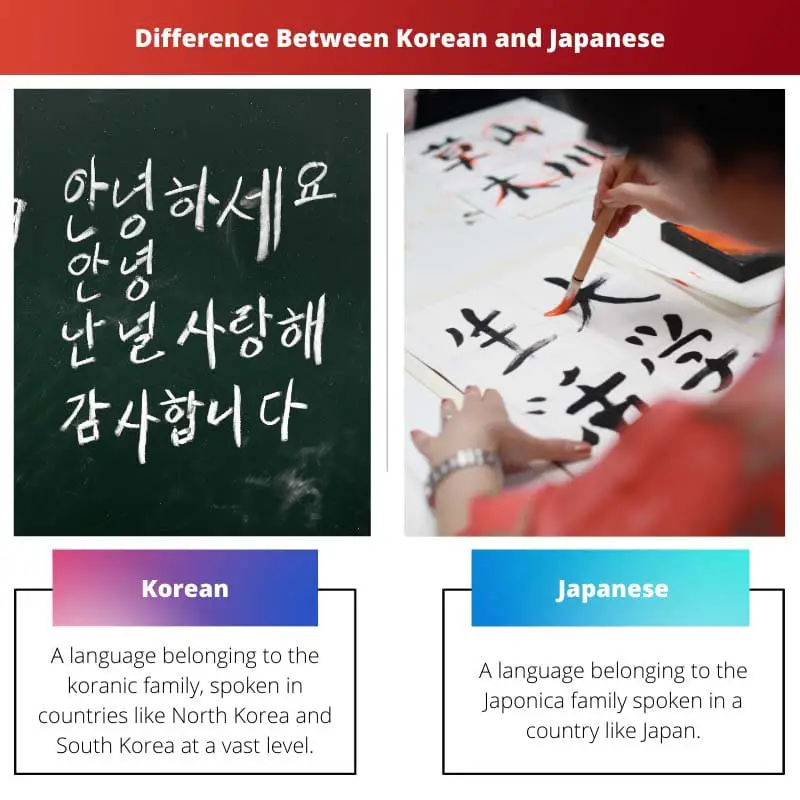Korean and Japanese are two such languages that are very connected to each other due to their history and geography, but these two are still very different from one another,
and it is very important to mark align of differences between them so that one does not get confused while identifying any of these.
Key Takeaways
- Korean and Japanese are distinct languages with unique grammar, vocabulary, and pronunciation.
- Korean uses Hangul script, while Japanese combines kanji, hiragana, and katakana.
- Korean cuisine emphasizes fermented and spicy flavors, while Japanese cuisine is known for using fresh ingredients and delicate flavors.
Korean vs Japanese
Korean is the official language of South Korea and North Korea. Korean communities also speak it in other countries, such as the United States and Canada. Japanese is the official language of Japan and is also spoken by Japanese communities in other countries. Japanese belongs to the Japonic language family and is related to the Ryukyuan languages.

Korean is a language that is popular worldwide regardless of the region it is mostly spoken in. Approximately 75 million people speak this language, and most of the speakers reside in either South Korea or North Korea.
But apart from these two countries, this language is spoken in the United States and Japan as well. This language is a very historical and cultural language and holds utter significance for the people of Korea.
It somehow resembles Japanese but can be distinguished from the same very easily.
But on the other hand, Japanese is a language that somehow looks like Korean but happens to be completely different. This language is spoken by almost 127,000,000 people all over the world, and most of the speakers belong to Japan only.
The first exact literature on this language was found somewhere around the 8th century, and the time period belonging to this language is divided into five groups mainly.
However, owing to all the advancements happening today, this language has transformed itself so much that it is now clearly different from what it used to be years ago.
Comparison Table
| Parameters of Comparison | Korean | Japanese |
|---|---|---|
| Meaning | A language belonging to the koranic family, spoken in countries like North Korea and South Korea at a vast level. | a language belonging to the Japonica family spoken in a country like Japan. |
| Spoken in | The major three parts of the world where this language is spoken are North Korea, South Korea, and China. | The major parts of the world where this language is spoken are Japan, North America, South America, etc. |
| Spoken by | This language is spoken by nearly 75 million people | This language is spoken by nearly 127,000,000 people |
| Recognition | This language is the recognized language in North and South Korea | This language is the recognized language only in Japan. |
| Alphabets | In this language the Hangul alphabet is used, in which letters are composed not the syllables. | In this language, the Kana alphabet is used, in which each letter happens to relate to a syllable |
| Chinese Characters Usage | Hanja characters of the Chinese language are used in this language. | Kanji characters of the Chinese language are used in this language. |
What is Korean?
On the map of the planet Earth, we can see Korea situated near China and Japan. This factor has influenced the development of the Korean language so much that we can easily interpret it.
It can basically be explained as a language that happens to be South Asian and a national and official language of both North and South Korea.
This language is spoken by almost 75 million people all over the world, and most of the speakers belong to North or South Korea.
However, certain speakers reside in Japan and China as well, and this is the reason for this language being used in these countries also.
In the 1st century BC, due to the emergence of Buddhism in countries like Korea and China, the Chinese language became known to Korean people, and this was the reason behind the development of the alphabetical system called Hangul.
However, in the 15th century, the Korean people tried to replace Hangul with Hanza, but they failed in the attempt, and Hangul is still the most recognized alphabetical system of the Korean language.
In terms of grammar and rules, this language is presumed to have nine parts of speech, and the sentence structure of this language follows a subject followed by an object followed by a verb.

What is Japanese?
Talking about Japanese is also a South Asian language but is spoken in a different part that is Japan. Almost 127,000,000 speakers are present in the whole world who prefer to speak this language.
But similar to Korean, this language is also widely influenced by the Chinese language, and it is very hard to trace the exact emerging point of this language in history.
Talking about the grammatical rules of this language, the sentence structure happens to be a subject followed by an object followed by a verb, but there are no genders when it comes to nouns and objectives.
It is a relatively simple language as it uses the pure verbal system and hardly indulges in the technicalities present in the Korean or Chinese language.
This language has never gained any official status in any of the countries, but it is still a national language in Japan, and this fact here gives it a prominent status among all the languages that are present in the whole world, as Japan in itself is a very influential country.

Main Differences Between Korean and Japanese
- Korean belongs to the Koranic family of languages and is spoken in North Korea and South Korea at a major level. But on the contrary, Japanese belongs to the Japonica family and is spoken in Japan.
- While Korean is spoken by almost 75 million people, Japanese is spoken by 127,000,000 people.
- Korean is a recognized language in North and South Korea, while Japanese is a recognized language in Japan.
- In Korean hangul alphabet is used, but in Japanese kana alphabet is used.
- In career Hanja, characters of the Chinese language are used to express ideas, but in Japanese, kanji characters of the Chinese language are used.

References
- https://books.google.com/books?hl=en&lr=&id=Sx6gdJIOcoQC&oi=fnd&pg=PR15&dq=korean+language&ots=qqM_m84UoD&sig=6rXHVnCx8NJ6AyHrmUkVaTt8QlQ
- https://books.google.com/books?hl=en&lr=&id=2AmspKX3beoC&oi=fnd&pg=PR5&dq=korean+language&ots=saGczbHVTE&sig=wrKzeI6IHebvFvwxgmPiaw99_WU
- https://eric.ed.gov/?id=ED417606

The overview of Korean and Japanese languages offers valuable insights into the linguistic characteristics, geographical influences, and cultural associations of each language. The clarity in distinguishing their differences provides a comprehensive understanding.
Absolutely, the detailed exploration of the linguistic, cultural, and historical elements of Korean and Japanese is enlightening.
Korean and Japanese languages have distinctive linguistic, grammatical, and cultural elements. This thorough analysis of their differences highlights the unique historical and geographical roots that shape their individual identity and significance.
The language comparison shows that Korean and Japanese are not only spoken in different countries, but also differ significantly in the recognition and usage of alphabets and Chinese characters. It’s interesting to trace the historical development of both languages and their alphabets.
The distinctions in recognition and usage of alphabets are important in understanding the unique written forms in both languages, and how they relate to the larger linguistic landscape.
I agree. The historical context behind the development of the alphabets provides valuable insights into the cultural and linguistic influences on the languages.
The comprehensive comparison of Korean and Japanese languages provides a compelling view of their distinct linguistic, historical, and cultural attributes. This exploration is crucial for appreciating the diverse heritage and rich linguistic traditions.
Yes, the detailed comparison offers a fascinating insight into the diverse linguistic and cultural elements represented by Korean and Japanese.
Absolutely, understanding the nuanced differences between Korean and Japanese enhances our awareness of their cultural and linguistic diversity.
The discussion of Korean and Japanese languages provides an in-depth look at the geographical influences, historical roots, and linguistic characteristics that define the uniqueness of each language. Understanding these features is essential to appreciate their individual cultural significance.
Indeed, the linguistic and cultural significance of these languages is notable. Their distinct elements contribute to their rich cultural and historical heritage.
The comparison table clearly depicts that Korean and Japanese are distinct languages with unique grammatical, vocabulary, and pronunciation differences. Korean employs the Hangul script while Japanese uses kanji, hiragana, and katakana. Also, the number of speakers of each language varies significantly.
Absolutely, it’s crucial to understand the differences and the unique aspects of each language to avoid confusion and misinterpretation.
The detailed analysis and comparison of Korean and Japanese languages highlight their unique linguistic and cultural features. Understanding the intrinsic differences between these languages enriches our insights into diverse linguistic heritages.
Indeed, the in-depth exploration of the linguistic and cultural aspects of Korean and Japanese languages provides rich insights into their heritage and diversity.
Absolutely, the comprehensive analysis enhances our understanding of the historical, geographical, and cultural influences that shape Korean and Japanese languages.
The detailed explanation of Korean and Japanese provides a fascinating insight into their historical origins, geographical roots, and linguistic intricacies. The comparison table effectively highlights the differences between the two languages and their unique attributes.
Absolutely, the linguistic differences and cultural influences portrayed in the article present a comprehensive understanding of the two languages.
The historical and geographical context of Korean and Japanese languages offers a comprehensive understanding of their development and unique features. Exploring their linguistic characteristics enriches our knowledge and appreciation of diverse linguistic cultures.
Definitely, the linguistic and cultural intricacies of these languages reflect the diverse heritage and linguistic traditions they represent.
The article’s detailed portrayal of Korean and Japanese languages emphasizes the nuances of their historical evolution, linguistic distinctions, and cultural significance. Understanding the unique elements of each language contributes to a broader cultural and linguistic perspective.
Absolutely, the linguistic and cultural significance of these languages is notable. Their distinct elements contribute to their rich cultural and historical heritage.
Yes, the detailed comparison enhances our understanding of the linguistic and cultural diversity represented by Korean and Japanese.